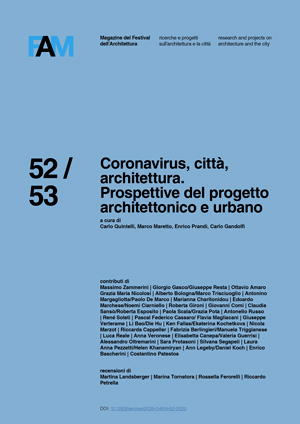Post-pandemia e morfologia urbana. Prospettive preliminari di ricerca degli impatti spaziali sulla sfera pubblica
Pubblicato 2020-12-11
Parole chiave
- Covid-19,
- Morfologia urbana,
- Spazi pubblici,
- Distanze sociali,
- Prossimità spaziale
Come citare
Abstract
Come evidenza del CoVid-19, la densità urbana[1] si è dimostrata un fattore di rischio per la salute, accelerando la riflessione verso una maggiore sostenibilità. L’indagine sulle strategie post-pandemiche nelle città di Milano e Rotterdam mostra emergenti modalità di riappropriazione spaziale di aree pubbliche residuali per una migliore capacità di adattamento al rischio.
[1] “Density is really an enemy in a situation like this, with large population centers, where people are interacting with more people all the time, that’s where it’s going to spread the fastest.” (Dr. Steven Goodman, epidemiologo della Stanford University). Citato in: Brian M. Rosenthal (Marzo, 23, 2020) “Density Is New York City’s Big ‘Enemy’ in the Coronavirus Fight” su
https://www.nytimes.com/2020/03/23/nyregion/coronavirus-nyc-crowds-density.html (accesso 08. 05.2020, 11:00)
Riferimenti bibliografici
- Allen, P (2012) – Cities: The visible expression of co-evolving complexity. In: Portugali J, Meyer H, Stolk E and Tan E (eds) Complexity Theories of Cities Have Come of Age: An Overview with Implications to Urban Planning and Design. Berlin: Springer-Verlag, 67–89.
- Balducci, A, Boelens, U, Hillier, J. (2011) – “Introduction: Strategic spatial planning in uncertainty: Theory and exploratory practice”. Town Planning Review 82(5), 481–501.
- Beck, U. (2013) – La società del rischio. Verso una seconda modernità. Roma: Carocci editore.
- Bergevoet, T., van Tuijl, M. (2016) – The Flexible City: Sustainable Solutions for a Europe in Transition. Rotterdam: Nai Publishers.
- Berlingieri, F., Triggianese, M. (2019) – “Spazio pubblico tra densificazione e responsabilità ambientale: il caso di Rotterdam”. L’Industria delle Costruzioni 467, 54-61.
- Bishop, P. and Williams, L. (2012) – Temporary city. Routledge: Oxon.
- Carmona, M, Tiesdell, S, Heath, T (2010) – Public Spaces, Urban Spaces. Oxford: Architectural Press.
- Carmona, M. (2015) – “Re-theorising contemporary public space: a new narrative and a new normative”. Journal of Urbanism: International Research on Placemaking and Urban Sustainability, 8(4), 373-405.
- Comune di Milano (2020) – “Milano 2020 Strategia di adattamento, documento aperto al contributo della città”. Un processo partecipato e aperto ai cittadini e portatori di interessi, pubblicato il 27 Aprile: https://www.comune.milano.it/aree-tematiche/partecipazione/milano-2020.
- Corner, J. (1997) – Ecology and landscape as Agents of Creativity. In: Reed, C. and Lister, N.M. (Eds.) (2013) Projective Ecologies. Harvard: Harvard University Graduate School of Design and Actar.
- van Eck E., van Melik R., e Schapendonk J., (2020) – Marketplaces as public spaces in times of the covid-19 coronavirus outbreak: first reflections. In Tijdschrift voor Economische en Sociale Geografie, John Wiley & Sons Ltd (2020, in pubblicazione).
- Freestone, R. (2012) – Urban Planning in Changing World: The Twentieth Century Experience. London: Routledge.
- Haydn, F. and Temel, R. (2006) – Temporary urban spaces. Concepts for the use of cities spaces. Birkhauser: Basel.
- Healey, P (2007) – Urban Complexity and Spatial Strategies: Towards a Relational Planning for Our Times. London: Routledge.
- Honey-Roses, J. et al. (2020) – “The Impact of COVID-19 on Public Space: A Review of the Emerging Questions”. In: OSF Preprints.
- Hu W., e Haag M., (Giugno, 29, 2020) “Public Spaces Weren’t Designed for Pandemics. N.Y.C. Is Trying to Adapt” su: https://www.nytimes.com/2020/06/29/nyregion/nyc-parks-playgrounds-plazas-coronavirus.html (accesso 07. 07. 2020, 9:00)
- Kamni Gill, et al. (2020) – “Corona, the Compact City and Crises”. Journal of Landscape Architecture, 15:1, 4-5, DOI: 10.1080/18626033.2020.1792647
- Löw, M. (2016) – “Changes in Spatial Phenomena”. In: The Sociology of Space. Cultural Sociology. New York: Palgrave Macmillan.
- Lydon, M., Bartman, D., Woudstra, R. and Khawarzad, A. (2011) – Tactical Urbanism: Short-term action Long-term change. New York: The Street Plans Colla-borative.
- Oswalt, P., Overmeyer, K. and Misselwitz, P. (Eds.) (2013) – Urban Catalyst - The power of temporary use. Berlin: Dom Publishers.
- Reid C., (Aprile, 13, 2020) – “New Zealand First Country To Fund Pop-Up Bike Lanes, Widened Sidewalks During Lockdown” su: https://www.forbes.com/sites/carltonreid/2020/04/13/new-zealand-first-country-to-fund-pop-up-bike-lanes-widened-sidewalks-during-lockdown/#121f93a5546e (accesso 21. 07. 2020, 7:00)
- Simmel, G. (1908) – Soziologie. Leipzig: Duncker & Humblot.
- UN-HABITAT & World Health Organization. (2020) – Integrating health in urban and territorial planning: a sourcebook. World Health Organization.
- Valente, I. (2016) – Durata, in Marini, S., Corbellini, G. eds (2016) Recycled Theory: Illustred Dictionary / Dizionario illustrato. Macerata, Quodlibet.
- Zukin, S. (1998) – “Urban Lifestyles: Diversity and Standardisation in Spaces of Consumption”. Urban Studies, 35, 825-839.
- ZUS (2016) – The New Re-public – City of Permanent Temporality. Rotterdam: NAi010 Booksellers.

